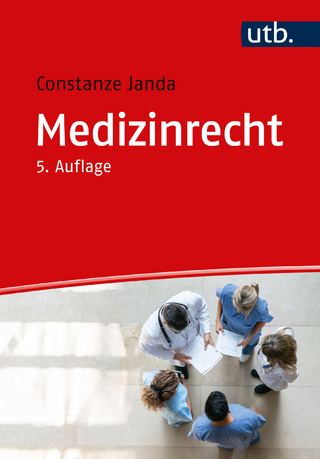
Bioethics
Health Care Law and Ethics
Seiten
2022
|
9th Revised edition
West Academic Press (Verlag)
978-1-68467-714-6 (ISBN)
West Academic Press (Verlag)
978-1-68467-714-6 (ISBN)
Uses a variety of legal and interdisciplinary materials to engage students in the study of the intersection of bioethics and law. The book includes judicial opinions, statutes, regulations and policies from health care organisations and professional associations.
Bioethics: Health Care Law and Ethics uses a variety of legal and interdisciplinary materials to engage students in the study of the intersection of bioethics and law. It includes judicial opinions, statutes, regulations and policies from health care organizations and professional associations to give students insight into the strategies and methods used by courts, legislatures, administrative agencies, and health care organizations to address issues in bioethics. The book draws from interdisciplinary research to provide critiques of legal and policy issues. Materials in this text are tightly edited and designed to create high quality and focused classroom discussion. They include classroom-tested problems that engage students with the material.
This text begins with an introductory chapter that provides a valuable foundation for exploring the relationship between law and ethics in the rest of the book. It begins by presenting a practical method for ethical analysis of specific cases. It next provides an accessible survey of the most influential theories of ethics in bioethics, including foundational theories, principlism, natural law, and critical race, feminist, and disability theories. The chapter then revisits the relationship between law and ethics through more specific examples, including the role of conscience and informed consent law. Finally, this chapter highlights issues of justice and equity incorporated throughout the remaining chapters.
As health care access has increasingly been viewed as matter for bioethics and health care ethics, Chapter 2 covers Discrimination and Unequal Treatment in Health Care. This chapter has been significantly expanded with new cases on sex discrimination in the areas of reproductive and gender-affirming care. Its focus has also been expanded beyond discrimination in medical decision-making and access to providers, to include concerns about discriminatory insurance design. Finally, we've expanded our discussion of the conflicts arising out of religious objections to nondiscrimination mandates.
The chapter on Reproduction and Birth has been updated with material on the most recent controversies and developments concerning abortion, contraception, and assisted reproductive technology (ART). It has also expanded its discussion of issues implicating reproductive justice concerns, such as forced or coerced sterilizations, denial of ART, and forced medical interventions and other liberty infringements of pregnant women—all of which have been disproportionately used on groups that have been subject to systemic discrimination and subordination.
This text includes several chapters on health care decision making in the context of life and death decisions. The material on Organ Transplantation and Determination of Death includes the basic framework for organ transplantation as well as new protocols for retrieval of organs after withdrawal of medical treatment. It also includes cases and notes on current controversies on the viability of the brain death standard. Two chapters treat what has been known as "end of life" decision making, including the legal and ethical norms for withdrawal of life-sustaining treatment and the legal and ethical status of medically assisted dying.
The chapter on Regulation of Research Involving Human Subjects treats both the federal regulation of research through the Common Rule and the impact of state law (primarily through private litigation over the rights of individuals participating in research). This chapter includes coverage of biobanks, public health research, research with children and other issues. Finally, the book closes with a significantly expanded chapter on Population Health and Public Health, analyzing the interaction between individual rights and community claims and incorporating important developments arising out of the challenges to COVID-19 pandemic public health measures.
Bioethics: Health Care Law and Ethics uses a variety of legal and interdisciplinary materials to engage students in the study of the intersection of bioethics and law. It includes judicial opinions, statutes, regulations and policies from health care organizations and professional associations to give students insight into the strategies and methods used by courts, legislatures, administrative agencies, and health care organizations to address issues in bioethics. The book draws from interdisciplinary research to provide critiques of legal and policy issues. Materials in this text are tightly edited and designed to create high quality and focused classroom discussion. They include classroom-tested problems that engage students with the material.
This text begins with an introductory chapter that provides a valuable foundation for exploring the relationship between law and ethics in the rest of the book. It begins by presenting a practical method for ethical analysis of specific cases. It next provides an accessible survey of the most influential theories of ethics in bioethics, including foundational theories, principlism, natural law, and critical race, feminist, and disability theories. The chapter then revisits the relationship between law and ethics through more specific examples, including the role of conscience and informed consent law. Finally, this chapter highlights issues of justice and equity incorporated throughout the remaining chapters.
As health care access has increasingly been viewed as matter for bioethics and health care ethics, Chapter 2 covers Discrimination and Unequal Treatment in Health Care. This chapter has been significantly expanded with new cases on sex discrimination in the areas of reproductive and gender-affirming care. Its focus has also been expanded beyond discrimination in medical decision-making and access to providers, to include concerns about discriminatory insurance design. Finally, we've expanded our discussion of the conflicts arising out of religious objections to nondiscrimination mandates.
The chapter on Reproduction and Birth has been updated with material on the most recent controversies and developments concerning abortion, contraception, and assisted reproductive technology (ART). It has also expanded its discussion of issues implicating reproductive justice concerns, such as forced or coerced sterilizations, denial of ART, and forced medical interventions and other liberty infringements of pregnant women—all of which have been disproportionately used on groups that have been subject to systemic discrimination and subordination.
This text includes several chapters on health care decision making in the context of life and death decisions. The material on Organ Transplantation and Determination of Death includes the basic framework for organ transplantation as well as new protocols for retrieval of organs after withdrawal of medical treatment. It also includes cases and notes on current controversies on the viability of the brain death standard. Two chapters treat what has been known as "end of life" decision making, including the legal and ethical norms for withdrawal of life-sustaining treatment and the legal and ethical status of medically assisted dying.
The chapter on Regulation of Research Involving Human Subjects treats both the federal regulation of research through the Common Rule and the impact of state law (primarily through private litigation over the rights of individuals participating in research). This chapter includes coverage of biobanks, public health research, research with children and other issues. Finally, the book closes with a significantly expanded chapter on Population Health and Public Health, analyzing the interaction between individual rights and community claims and incorporating important developments arising out of the challenges to COVID-19 pandemic public health measures.
| Erscheinungsdatum | 31.05.2022 |
|---|---|
| Reihe/Serie | American Casebook Series |
| Verlagsort | Minnesota |
| Sprache | englisch |
| Maße | 186 x 254 mm |
| Gewicht | 515 g |
| Themenwelt | Naturwissenschaften ► Biologie |
| Recht / Steuern ► EU / Internationales Recht | |
| Recht / Steuern ► Privatrecht / Bürgerliches Recht ► Medizinrecht | |
| ISBN-10 | 1-68467-714-9 / 1684677149 |
| ISBN-13 | 978-1-68467-714-6 / 9781684677146 |
| Zustand | Neuware |
| Haben Sie eine Frage zum Produkt? |
Mehr entdecken
aus dem Bereich
aus dem Bereich


